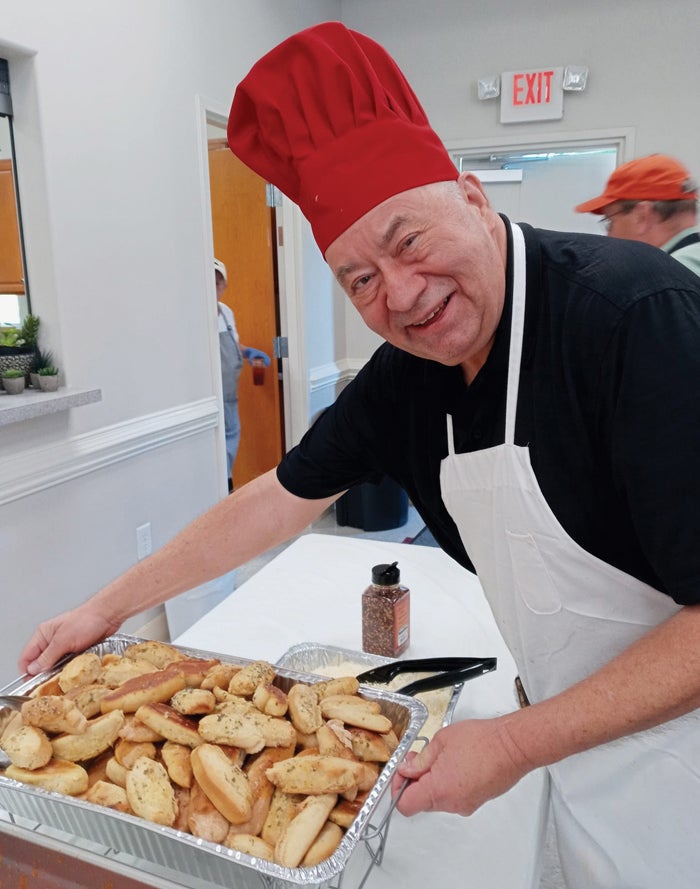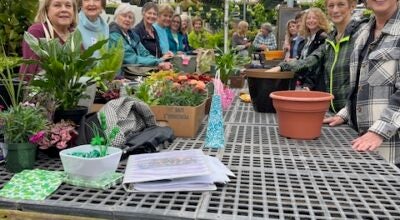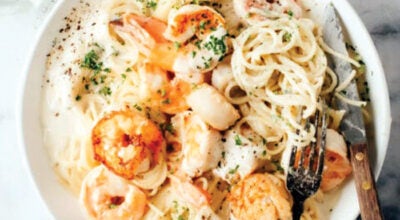Bless Your Spoon: Ham Club is not about ‘country’ hams
Published 12:00 am Thursday, May 19, 2022

- A member of the Amateur Radio Club, Chef Don Johnson is no amateur when it comes to cooking Spaghetti and Bread Sticks for a crowd.
|
Getting your Trinity Audio player ready...
|
By Stephanie Williams Dean
When invited to attend a Ham Club meeting and dinner, I expected to hear some amateur comedian hamming it up. We must have had a faulty transmission somewhere and got our lines crossed. At the very least, I thought some classic ham dish would be served, but that wasn’t relayed correctly, either. But that night, I did have some interchanges with a few folks regarding hams — ham operators. And I was wired when seeing Forsyth Amateur Radio Club, Inc. was serving beef and noodles. The beloved, old-fashioned spaghetti supper had been revived.
Spaghetti suppers go way back, but not as far as the history of amateur radio — that would be 1934. When I was growing up in the ’60s, the spaghetti supper was the deal and it seemed every school PTA had one. A popular fundraiser, the suppers successfully fed a large crowd. Now rivaled by chicken and oyster stews, BBQs and chili cook-offs, the spaghetti dinner appears to have all but had its day. But to my delight, now and again, the old-fashioned supper still connects with some folks.
Before meeting Chef Don Edwards, I never knew there was so much intelligence to be reported regarding spaghetti and breadsticks. Boy, was I wrong. While a member of the amateur radio club, Don’s also a chef but he’s no amateur at cooking. Professionally, he was a scientist and biomedical engineer, retiring from Reynolds Tobacco. Don was only 10 years old when he became a ham operator and he’s now 69. As the club’s media chairman and editor, he’s responsible for a 50-page monthly newsletter.
For Don, cooking is a passion, not a profession. The chef became proficient at cooking for large groups while a Scoutmaster for the Boy Scouts and at camp Raven Knob. Learning to bake while hiking the Appalachian Trail in his late teens, Don noted, “Did you know, all it really takes is self-rising flour, water, and a hot flat rock on some coals? Everything else is just polish, that and the butter and coarse salt crystals.”
Three varieties of spaghetti were served — beef with mushrooms, beef without mushrooms and a vegetarian recipe. The mushrooms were cooked in Kelly Gold Butter, a pure salted butter from Ireland and you can find it in any grocery. Don chopped Vidalia onions and added minced fresh garlic, cooking them in the butter until translucent before adding the beef.
“Onions, garlic, and tomatoes become my ‘moipoix’,” commented the chef.
Fresh Roma tomatoes and 7 pounds of 88-90% beef were used to prepare spaghetti for 100 people. He did cut one corner, saying, “I cheated. I used a little Italian seasoning.” I think we can all forgive him for that small indiscretion.
One oversight when preparing his spaghetti was pepper. And surprisingly so, as he’s all about pepper, saying, “When I taste something, I can feel it over my entire body. I can tell exactly where pepper comes from,” He considers the best pepper to be from the Malabar Coast of India but agrees some Vietnamese peppers are as good as any. Don buys coarse ground but prefers to grind his own.
I didn’t notice a thing missing — the spaghetti was delicious. Many accolades to the chef were conveyed before the meeting was over. The origin of Don’s spaghetti recipe wasn’t disclosed, but he thinks it came from a friend.
A multi-veggie salad bar and homemade, fresh buttermilk dressing were served with the pasta. Toasted, yeasty garlic breadsticks were made from scratch. The bread was brushed with a thin spread of Kellygold butter and sprinkled with dried parsley flakes, freshly pressed garlic and a shake of Kosher salt — his secret addition.
Ghirardelli chocolate brownies followed, which were rich and chocolaty and served with a scoop of vanilla or fudge ripple ice cream and drizzled with Hershey’s chocolate syrup. As many Southern grandmas have reported, “we was full as ticks.”
Amateur radio is a formal communications service administered by the Federal Communications Commission. It provides emergency backup communications and encourages people to connect with folks over airwaves person to person. When natural disasters occur, such as hurricanes or earthquakes, and commercial systems are knocked out, the hobby of “hams” is especially useful. Backup communication is often provided for hours, days, weeks or months until services are restored. Learning the world of radio communications gives you access to the most capable set of communication privileges. Journey through amateur radio by checking out the club website or attend a meeting. Meetings are held at 7:30 p.m. on the second Monday of every month at the Red Cross on Coliseum Drive in Winston-Salem. For more information, go to the club’s website at www.w4nc.com.
Did you know we were born with a built-in communication system? When personal situations arise, we can transmit our feelings straight to God. The Bible has much to say about communication. God talks to us through the Holy Spirit in us and through his word. God helps us understand his word and apply it to our lives. We can talk back to God through prayer or time spent reading the Bible. When we give our time to these disciplines, we begin to discern God’s voice over the noise of this world. The Holy Spirit begins speaking to us, and we begin to hear God through those around us, circumstances, and even our conscience. Good communication with God and people has a lot to do with listening.
“Christians have forgotten that the ministry of listening has been committed to them by him who is himself the great listener and whose work they should share. We should listen with the ears of God that we may speak the Word of God.” — Dietrich Bonhoeffer
Don’s Spaghetti Sauce Family Size
1-2 Tbsp. Kellygold butter
10 ¼-inch sliced large mushrooms
Extra virgin olive oil
1 Vidalia or Peruvian sweet onions
3 minced cloves garlic
5 fresh Roma tomatoes
14.5 oz. Contadina diced tomatoes
1 pound browned ground beef
1 Tbsp. tomato paste
1 seeded, cored, diced large green pepper
¼ cup extra virgin olive oil
1 Tbsp. Italian seasoning
½ Tbsp. basil
2 tsp. salt
2 bay leaves
¼ cup extra virgin olive oil
Vegetable broth, Balsamic vinegar (optional)
All-purpose flour (optional)
Fresh Parmesan cheese
Regular spaghetti noodles
Mushrooms are optional in your sauce. If included, in a skillet, melt Kellygold butter and sauté mushrooms until brown. Set aside. In a large pot, brown onions in olive oil until translucent, then add garlic. Add fresh tomatoes and cook. The French call this Moipoix (pronounced meer-PWAH) — the aromatic ingredients cooked down in butter or oil without browning them. Cook fresh tomatoes down for 15-30 minutes, and then add the canned tomatoes (optional). He prefers the Contadina brand. The canned tomatoes help “extend” your sauce, but you can skip this step if preferred. Mix in browned beef and tomato paste. Add diced green pepper and mix well. Don prefers adding the peppers with the hamburger as he likes a little more crispness to the peppers. Add olive oil and mix in spices. For extra flavor, or if you need to thin your sauce, add some vegetable broth. If the sauce is too thin, you can add some all-purpose flour to thicken it back up. Go slow with the flour as it takes a few minutes to thicken. If you think sauce is too sweet, a little vinegar will kill the sweetness. Simmer sauce for 2-3 hours before serving. For the spaghetti, it’s cheap, so go all in and don’t scrimp! Plan on 2 or more ounces per person. For “al dente,” cook for 10 minutes in a rolling boil and don’t overcook. Rinse and drain. Buy genuine Italian or American parmesan cheese and grate your own. Spaghetti is so much better with real cheese on top. A hand-crank cheese grater is worth the $30 investment and does more than just cheese. Top with black olives and fresh parsley if you want to be fancy! Leftover sauce is excellent for freezing in appropriate-sized containers.
Don’s Classic Spaghetti Supper for 100
This larger recipe makes around 5 gallons. Don splits this sauce recipe into gallon pots. His three options are 2 gallons of mushrooms with beef, 2 gallons of no mushrooms with beef, or 1 gallon of vegetarian, including mushrooms with no beef. The recipe will feed 100 people. Use 2-4 Tbsp. Kellygold butter, 3-4 24-oz. Cosco-sized trays of mushrooms, 4 Vidalia onions, 36 cloves garlic, 40-50 Roma tomatoes, 30 oz. Contadina diced tomatoes, 7 pounds of hamburger, 4 Tbsp. tomato paste, 6 green peppers, and if you divide up the recipe, you need to split ingredients accordingly. When adding olive oil, each gallon of sauce gets ½ cup of oil per gallon. You can do that math. For spices, 2 Tbsp. to the large pots and 1 for the vegetarian sauce. For salt, 2 Tbsp. to each big pot and 1 Tbsp. for veggie pot. Cumin is 1 tsp. per pot. You can add cayenne pepper and red pepper flakes if you prefer. While some like it hot, Don prefers it not. For extra flavor or to thin sauce, vegetable broth is 1½ cup for large pots and ¾ cup for the veggie sauce.
Breadsticks
3 pkg. yeast
¼ cup warm water
3⁄4 cup milk
1⁄4 cup sugar
1/8 cup Crisco
1 teaspoon salt
1 ½ cup bread flour
1 egg
1½ cup bread flour
Kellygold butter
Morton Kosher salt
2-3 crushed cloves garlic
Dried parsley/rosemary flakes
Heat water in microwave to 105-115 degrees. Heat is important and 110 is ideal. The colder the yeast, the longer it takes to rise. Too hot, and you kill the yeast. Add water to yeast, mix and set aside. In a microwave, heat the milk, sugar, Crisco and salt to 105-115 degrees. Transfer to a mixer bowl. Add to yeast and water and mix. Then add egg and 1½ cup bread flour, a little or a time or sift. Sifting will make it easier to mix with electric mixer with bread hook or a spoon. Batter will be thin. After mixing, add another 1½ cups of flour and mix with wooden spoon. Knead the dough by hand for 5 minutes. You will need additional flour to add until this becomes consistency of Play Dough. The dough should not be sticky at this point. Put the dough into a bowl that’s been oiled, turning it to cover lightly with oil. Cover with plastic and chill. It will keep for several days and continue to rise. Cover two baking trays with parchment paper, one per loaf. Shape dough into two loaves, 3-4 inches wide, and 1 inch tall. Cover with towel and allow to rise in warm place for at least 50 minutes. Then take sharp knife and cut loaves into little strips about 1-inch wide, 3-5 inches long, and spread them out on trays with 1-inch separation. Cover again with towel and allow to rise 30 minutes. With a knife, cut a notch down the center of each stick for the butter. Bake in a preheated 400-degree oven for 15-20 minutes until brown and toasty. When done, brush tops with garlic butter and sprinkle dried parsley or rosemary on top. Sprinkle with coarse ground kosher salt crystals. The melted butter will hold the salt crystals in place. The salt adds much flavor, the coarseness of the salt adds texture, and since most of this is added last, it gives more flavor with less sodium. Baking is as much science as it is art. Cups are a poor way to measure flour. For the scientist in you, weigh the flour on a scale — 120 grams equals one cup.
Small Batch Ghirardelli Brownies
2 beaten eggs
1 1/8 cup of sugar
½ cup self-rising flour
1 tsp. vanilla extract
¼ salted butter
3 oz. unsweet Ghirardelli chocolate
2/3 cup chopped pecans
In a mixer bowl, beat eggs. Add sugar and mix well. Beat in flour and mix well. In a saucepan, melt butter and chocolate over low heat. Beat in vanilla extract and the butter-chocolate mix to the egg mixture. Mix well. Pour into a greased and floured 8×8 square cake pan. Bake in a preheated 325-degree oven for 25-30 minutes or until firm.



